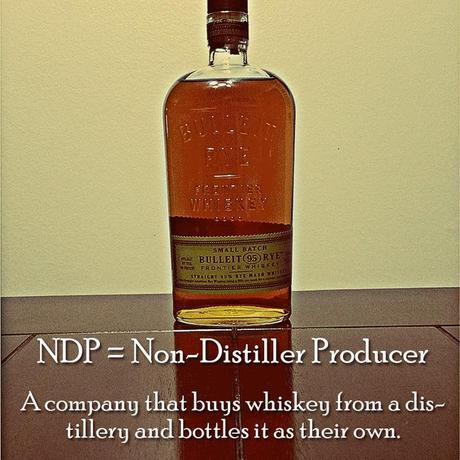
NDP stands for Non-Distiller Producer which is any company that gets it’s whiskey from another distillery and then bottles, and markets, it as their own. As a practice I have nothing against it, I don’t even have anything against them not disclosing where their whiskey comes from. What I have a problem with are all the unnecessary lies and stories people feel compelled to concoct about the origins of that whiskey.
In Scotland NDPs have been common practice for a very long time. The practice of buying barrels and putting your label on them is how the the entire industry of blended Scotch works with companies buying whisky from multiple distilleries and then blending them together, often with the addition of grain whisky, to create their own unique product. Blended Scotch makes up around 90% of the overall Scotch market so it’s safe to say the practice is more commonplace than not and that NDPs have been extremely instrumental in scotch working it’s way around the globe.
Blended Scotch drinkers don’t get themselves in a tizzy because they don’t know which distilleries their whisky came from like Americans do with their Bourbon and Rye… and I think I know at least one reason why. It’s all about the story the brands weave. In Scotland 100% of the blended brands tell you they don’t make the whisky (it’s on the label… the word blended). They rarely disclose what single malts are in the bottle and no one ever cares because they are not claiming to have distilled it themselves. If they did, then we’d be seeing some outrage.
Now move up the chain and take a look at the field of Independent Bottlers of single malts like McClelland’s and Alexander Murray & Co. who also have no problem saying they didn’t create the whisky in their bottle, but also do not always disclose where it’s from. Again, no one truly cares because they’re not claiming to have distilled it and if it’s a good whisky for a good price we’ll drink it and enjoy it all the same.
Finally at the top of the Scottish NDP ladder you you have folks like Cadenhead, Signatory or Samaroli who will proudly display the name of the distillery their bottling is from. However, those are special situations with a massive history all their own and are a bit more of an exception than the rule. All in all, NDPs have played a very important role in the growth of the Scotch industry and is of less concern than other issues like NAS whiskies, sulfur treated barrels, e150a and chill-filtering. 2 / 4 of which we don’t have to worry about here in America (1/2 if you’re a math nerd).
Here in America the NDP practice is essentially the same; buy whiskey from a distillery, put your own label on it and market it as your own. So why does no one truly care about the practice with Scotch, but when it comes to bourbon and rye the Internet goes into hysterics when the worst kept secret in the whiskey world gets “uncovered”? Because in Scotland few NDPs pretend to have distilled what’s in their bottles compared to their American cousins who seem to be locked in a furious battle of bourbon bullshit one-upmanship.
Here in America you have brands that buy their whiskey else where, but still call themselves distilleries even though they don’t distill a single thing. Some of them will even go so far as to get some red-faced redneck to stand in front of a still, that sometimes isn’t working or even their’s, for some photos and then they call him their Master Distiller even though he, like the company, doesn’t distill a damn thing. Then they’ll top it all off by weaving some enormous bullshit tale about how they found an old bootlegger’s recipe for whiskey buried beneath a tree stump in the woods and they based their hooch off of that.
Compare that to Scotch NDP brands (sometimes called “bastard malts” by those cheeky Malt Maniacs) like Smokehead and Finlaggan who don’t even attempt to act like they distilled it. Smokehead’s site makes no allusions to distillation what-so-ever by avoiding the subject altogether. Then you have Finlaggan whose site flat out says it: “Finlaggan is very much the SECRET Islay, as the name of the distillery from which it comes is a closely guarded secret.” And THAT, right there, is the difference. Transparency.
I don’t care that someone buys their whiskey from somewhere else and puts their name on it, it’s when they lie to my face about it. Folks like Tom Perkins at High West Distillery are a perfect example of the RIGHT way to do it. He’s very open and honest about where his whiskey comes from (when legally permitted) and with each bottle you still get the same theatrics and story behind each expression that adds to the fun of drinking good whiskey. Though what sets Perkins and Co. apart from their less scrupulous competitors is that they never claim or even allude to making a single drop they didn’t actually make. Yet they still manage to have a fun and vibrant brand that’s known for quality and has paved the way for them to start bringing their own whiskey to market with an eager fan base already in place.
To see the other side of the coin though there is no better place to start than in Templeton, Iowa. Here you’ll find Templeton Rye Spirits (LLC) who claims that Templeton Rye was the favorite whiskey of notorious mobster Al Capone and was produced illegally all through prohibition and for some time after, but then magically returned as a legal beverage in 2006. This farce goes on and as you read through their site which is heavy with allusions to distilling including some very in-depth information on the subject of distillation. They work very hard to fabricate this illusion that they are a craft distillery, hell they even have a Master Distiller, but the truth is they don’t distill a drop there. It’s all made, every single molecule, by distillery-for-hire MGP who pumps out nameless whiskey for anyone who wants to buy a barrel and call it theirs.
I have nothing against MGP (though I’ve seen plenty of unwarranted venom slung in their direction) and I have nothing against NDPs. The only problem that exists in this whole scenario are the people who create bullshit stories and lie through their teeth about making a product they didn’t make. It’s just not necessary. It’s possible to create a fantasy brand that is fun, has great packaging and an interesting story without the lies. They just need to drop the whole “this is Al Capone’s whiskey” or “it’s based on John Wayne’s whiskey collection” nonsense.
Instead talk about how the story of Templeton Rye made you search out the best rye you could get your hands on and how you’re bringing the tradition of Rye whiskey being shipped out of Templeton back to Iowa. How you’re dedicated to seeing the brand once again adorn the shelves of modern bars, restaurants and speakeasies. That you’re proud of being able to source the best rye you possibly can and maturing it in Templeton to hopefully do justice to this once Iconic brand. Build a brand on truth and education instead of smoke and mirrors because the truth is that the modern, REAL, human story is far more interesting than any farce they concoct.
It’s a frustrating situation and I just wish there was a governing body whose job it was to enforce bottle labeling and ensure consumers knew where their whiskey was coming from… oh wait there is. It’s called the TTB (Alcohol & Tobacco Tax & Trade Bureau) and they approve all the labels that end up on beer, wine, etc. in the USA. They have a bunch of rules and guidelines about what can, can’t and has to be on the labels, but they don’t always enforce their own rules as is the case with rule 5.36(d) which states the following:
(d) State of distillation. Except in the case of ‘‘light whisky’’, ‘‘blended light whisky’’, ‘‘blended whisky’’, ‘‘a blend of straight whiskies’’, or ‘‘spirit whisky’’, the State of distillation shall be shown on the label of any whisky produced in the United States if the whisky is not distilled in the State given in the address on the brand label. The appropriate TTB officer may, however, require the State of distillation to be shown on the label or he may permit such other labeling as may be necessary to negate any misleading or deceptive impression which might be created as to the actual State of distillation.
Basically this means this whole mess could have been avoided in the first place if the TTB wasn’t asleep at the wheel because they are underfunded and overburdened. By no means does this render the guilty NDPs blameless, they’re still guilty of taking advantage of the situation to spin their yarns and spread misinformation, but if the TTB had been properly doing their job the whole time then it would never have progressed this far. So blame the Potemkin Distilleries, blame the TTB, hell even blame your self a little bit (I do), but don’t blame the whiskey sources like MGP/LDI. They’re not the ones serving you a glass of whiskey with a sidecar of horseshit.
Some other great articles about NDPs and TTB rule 5.36(d)
- Sku – Why isn’t the TTB Enforcing the State of Distillation Disclosure Rule?
- Chuck – We Pause to Collect Our Thoughts About 5.36(d) and Potemkin Distilleries
- Dramming – Bastard Malts – When You Don’t Know What’s in the Bottle
- Straight Bourbon – Where do NDP’s get their whiskey
- K&L Spirits Journal – The NDP Dilemma
On a side not Templeton has received so much pressure that they are changing their labels. So there is some hope for the future afterall.








